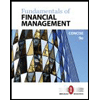
1.
Concept Introduction:
Earnings per Share: Earnings per share (EPS) is calculated by dividing a company's net profit by the total number of outstanding common shares. EPS is a popular statistic for determining corporate value, and it shows how much money a firm produces for each share of its stock.
The basic earnings per share.
2.
Concept Introduction:
Dividend Yield: Dividend yield illustrates how much a corporation pays out in dividends annually in relation to the price of its stock.
The dividend yield.
3.
Concept Introduction:
Price-earnings ratio: The relationship between a company's stock price and earnings per share is shown by calculating the price-earnings ratio. The market price per share must be divided by the EPS in order to derive the price-earnings ratio.
The Price Earnings ratio.
4)
Introduction: The relationship between a company's stock price and earnings per share is shown by calculating the price-earnings ratio. The market price per share must be divided by the EPS in order to derive the price-earnings ratio
Based on PE Ratio, Company having greater expectations about future performance.
Want to see the full answer?
Check out a sample textbook solution
Chapter 11 Solutions
FINANCIAL & MANAGERIAL ACCOUNTING
- Nonearrow_forwardWhat is the actual total direct materials cost for the current period of this accounting question?arrow_forwardHonda Company had sales of $165,000, sales discounts of $4,200, and sales returns of $5,300. Honda Company's net sales equal: A. $172,500 B. $165,000 C. $155,500 D. $9,500 E. $160,800arrow_forward
- General Account tutor please find solutionarrow_forwardMJ's Jewellery reported the following amounts at the end of the year: total jewellery sales = $650,000; sales discounts = $15,000; sales returns= $40,000; sales allowances = $20,000. Compute net sales.arrow_forwardPlease provide problem with accountingarrow_forward

 EBK CONTEMPORARY FINANCIAL MANAGEMENTFinanceISBN:9781337514835Author:MOYERPublisher:CENGAGE LEARNING - CONSIGNMENT
EBK CONTEMPORARY FINANCIAL MANAGEMENTFinanceISBN:9781337514835Author:MOYERPublisher:CENGAGE LEARNING - CONSIGNMENT Fundamentals Of Financial Management, Concise Edi...FinanceISBN:9781337902571Author:Eugene F. Brigham, Joel F. HoustonPublisher:Cengage Learning
Fundamentals Of Financial Management, Concise Edi...FinanceISBN:9781337902571Author:Eugene F. Brigham, Joel F. HoustonPublisher:Cengage Learning Fundamentals of Financial Management, Concise Edi...FinanceISBN:9781285065137Author:Eugene F. Brigham, Joel F. HoustonPublisher:Cengage Learning
Fundamentals of Financial Management, Concise Edi...FinanceISBN:9781285065137Author:Eugene F. Brigham, Joel F. HoustonPublisher:Cengage Learning Fundamentals of Financial Management, Concise Edi...FinanceISBN:9781305635937Author:Eugene F. Brigham, Joel F. HoustonPublisher:Cengage Learning
Fundamentals of Financial Management, Concise Edi...FinanceISBN:9781305635937Author:Eugene F. Brigham, Joel F. HoustonPublisher:Cengage Learning




